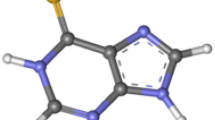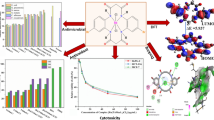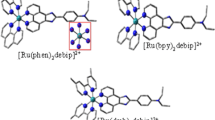Abstract
This study reports the synthesis, spectroscopic, molecular properties, and in silico biological assessment of ruthenium polypyridyl complexes with a hydroxypyridine ligand, [Ru(bpy)2(N^O)](PF6) (Ru-1) and [Ru(phen)2(N^O)](PF6) (Ru-2). The compounds have been characterized by FT-IR, UV, single crystal X-ray crystallography while molecular electronic properties have been considered within the framework of density functional theory (DFT) computation. The explicit interpretation of the vibrational spectra was assigned by the VEDA4e program. The results obtained from the natural bond analysis explicated that the highest stabilization energy E(2) for the Ru-2 molecule is 343.53 kcal/mol while the Ru-1 compound was observed to possess E(2) energy of 302.42 kcal/mol. The studied Ru-2 compound has been observed to exhibit high gastrointestinal absorption which might restrict the brain-blood barrier or any cytochrome p450 inhibition (1A2, 2C19, 3A4, and 3A4) without infringing any of the Lipniski rules. The molecular docking experiment reveal that the Ru-2 compound binds effectively with 2nv6 tuberculosis receptor with a corresponding binding affinity of − 8.6 kcal/mol obtained for Ru-1 molecule. However, when both compounds were docked with the 5syj receptor, the binding affinity was observed to be − 7.5 and − 6.7 kcal/mol for Ru-2 and Ru-1 respectively, which is comparably higher than the binding score observed for isoniazid standard drug. Ru-2 complex was observed to possess a high energy gap of 2.948 eV with a chemical softness of 0.678 eV, thus suggesting the studied molecule is highly stable and suitable and can be used as a potential anti-tubercular agent. The Uv–vis spectroscopy study divulged that all absorption spectra occurred at the visible region for both molecules respectively, which is in tandem with the obtained experimental λmax.






Similar content being viewed by others
Data availability
All data are contained within the manuscript and electronic supporting information (ESI).
References
Kumar V, Abbas AK, Fausto N, Mitchell RN (2007) Robbins Basic Pathology, 8th edn. Saunders Elsevier, pp 516–522
Ducati RG, Ruffino-Netto A, Basso LA, Santos DS (2006) The resumption of consumption: a review on tuberculosis. Mem Inst Oswaldo Cruz 101(7):697–714
DeVille K (1989) Robert koch: a life in medicine and bacteriology. Bioscience 39(7):493–495
Sahin C (2022) Synthesis, characterization, photophysical and electrochemical properties of pyridine based ruthenium complexes. Düzce Univ J Sci Technol 10(1):207–215. https://doi.org/10.29130/dubited.956216
Qian BF, Wang JL, Jia AQ, Shi HT, Zhang QF (2021) Syntheses, reactivity, structures and photocatalytic properties of mononuclear ruthenium(II) complexes supported by 1,4,7-trimethyl-1,4,7-triazacyclononane (Me3tacn) ligands”. Inorganica Chim Acta 516:120128
Zeng L, Gupta P, Chen Y, Wang E, Ji L, Chao H, Chen ZS (2017) The development of anticancer ruthenium (II) complexes: from single molecule compounds to nanomaterials. Chem Soc Rev 46(19):5771–5804
Lapasam A, Banothu V, Addepally U, Kollipara MR (2019) Half-sandwich arene ruthenium, rhodium and iridium thiosemicarbazone complexes: synthesis, characterization and biological evaluation. J Chem Sci 132:1
Dömötör O, Enyedy ÉA (2019) Binding mechanisms of half-sandwich Rh (III) and Ru (II) arene complexes on human serum albumin: a comparative study. J Biol Inorg Chem 24:703–719
Lenis-Rojas OA, Fernandes AR, Roma-Rodrigues C, Baptista PV, Marques F, Pérez-Fernández D, Guerra-Varela J, Sánchez L, Vázquez-García D, Torres ML, Fernández A (2016) Heteroleptic mononuclear compounds of ruthenium (II): synthesis, structural analyses, in vitro antitumor activity and in vivo toxicity on zebrafish embryos. Dalton Trans 45(47):19127–19140
Yu Q, Liu Y, Xu L, Zheng C, Le F, Qin X, Liu Y, Liu J (2014) Ruthenium (II) polypyridyl complexes: cellular uptake, cell image and apoptosis of HeLa cancer cells induced by double targets. Eur J Med Chem 23(82):82–95
Sahin C, Dittrich T, Varlikli C, Icli S, Lux-Steiner MC (2010) Role of side groups in pyridine and bipyridine ruthenium dye complexes for modulated surface photovoltage in nanoporous TiO2. Solar Energy Mater Solar Cells 94(4):686–90
Louis H, Mathias GE, Unimuke TO, Emori W, Ling L, Owen AE, Adeyinka AS, Ntui TN, Cheng CR (2022) Isolation, characterization, molecular electronic structure investigation, and in-silico modeling of the anti-inflammatory potency of trihydroxystilbene. J Mol Struct 15(1266):133418
Liang W, Luo X (2020) Theoretical studies of MoS2 and phosphorene drug delivery for antituberculosis drugs. J Phys Chem C 124(15):8279–87
Zhang Z, Wang Q, Xue J, Du Y, Liu J, Hong Z (2020) Vibrational spectroscopic investigation into novel ternary eutectic formed between pyrazinamide, fumaric acid, and isoniazid. ACS Omega 5(28):17266–74
Garg A, Borah D, Trivedi P, Gogoi D, Chaliha AK, Ali AA, Chetia D, Chaturvedi V, Sarma D (2020) A simple work-up-free, solvent-free approach to novel amino acid linked 1, 4-disubstituted 1, 2, 3-triazoles as potent antituberculosis agents. ACS Omega 5(46):29830–7
Frisch MJ, Trucks GW, Schlegel HB, Scuseria GE, Robb MA, Cheeseman JR, Scalmani G, Barone V, Mennucci B, Petersson GA, Nakatsuji H (2009) Gaussian 16. Gaussian Inc, Wallingford
Dennington R, Keith TA, Millam JM (2016) GaussView 6.0. 16. Semichem Inc, Shawnee Mission
Farrugia LJ (1997) ORTEP-3 for Windows-a version of ORTEP-III with a Graphical User Interface (GUI). J Appl Crystallogr 30(5):565
Hanwell MD, Curtis DE, Lonie DC, Vandermeersch T, Zurek E, Hutchison GR (2012) Avogadro: an advanced semantic chemical editor, visualization, and analysis platform. J Cheminf 4(1):1–7
Asogwa FC, Agwamba EC, Louis H, Muozie MC, Benjamin I, Gber TE, Mathias GE, Adeyinka AS, Ikeuba AI (2022) Structural benchmarking, density functional theory simulation, spectroscopic investigation and molecular docking of N-(1H-pyrrol-2-yl) methylene)-4-methylaniline as castration-resistant prostate cancer chemotherapeutic agent. Chem Phys Impact 5:100091
Trott O, Olson AJ (2010) AutoDock Vina: improving the speed and accuracy of docking with a new scoring function, efficient optimization, and multithreading. J Comput Chem 31(2):455–61
Dassault Systemes (2020) Discovery Studio Visualizer. Dassualt Systeme Biovia Corp, 2020
The PyMOL Molecular Graphics System, Version 1.2r3pre, Schrodinger LLC (2015) Available: https://pymol.org
Osigbemhe IG, Oyoita EE, Louis H, Khan EM, Etim EE, Edet HO, Ikenyirimba OJ, Oviawe AP, Obuye F (2022) Antibacterial potential of N-(2-furylmethylidene)-1, 3, 4-thiadiazole-2-amine: Experimental and theoretical investigations. J Indian Chem Soc 99(9):100597
Eno EA, Patrick-Inezi FA, Louis H, Gber TE, Unimuke TO, Agwamba EC, Ikenyirimba OJ, Akpanke JA, Oyoita E, Ejiofor EU, Adalikwu SA (2022) Theoretical investigation and antineoplastic potential of Zn (ii) Complexes of 6-Methylpyridine-2- carbaldehyde-N (4)- ethylthiosemicarbazone. Chem Phys Impact 5:100094
Jaziri E, Louis H, Gharbi C, Unimuke TO, Agwamba EC, Mathias GE, Fugita W, Nasr CB, Khedhiri L (2022) Synthesis, X-ray crystallography, molecular electronic property investigation, and leukopoiesis activity of novel 4, 6-dimethyl-1, 6-dihydropyridin-2-amino nitrate hybrid material. J Mol Struct 1268:133733
Louis H, Mathias GE, Ikenyirimba OJ, Unimuke TO, Etiese D, Adeyinka AS (2022) Metal-doped Al12N12X (X = Na, Mg, K) nanoclusters as nanosensors for carboplastin: insight from first-principles computation. J Phys Chem 126(27):5066–5080
Mohammadi MD, Abbas F, Louis H, Mathias GE, Unimuke TO (2022) Trapping of CO, CO2, H2S, NH3, NO, NO2, and SO2 by polyoxometalate compound. Comput Theor Chem 1215:113826
Mohammad MD, Abdullah HY, Louis H, Mathias GE (2022) 2D boron nitride material as a sensor for H2SiCl2. Comput Theor Chem 1213:113742
Osigbemhe IG, Oyoita EE, Louis H, Khan EM, Etim EE, Edet HO, Ikenyirimba OJ, Oviawe AP, Obuye F (2022) Antibacteria potential of N-(2-furylmethylidene)-, 3, 4-thiadiazole-2-amine: experimental and theoretical investigations. J Indian Chem Soc 99(9):100597
Louis H, Ifediora LP, Enudi OC, Unimuke TO, Asogwa FC, Moshood YL (2021) Evaluation of the excited state dynamics, photophysical properties, and the influence of donor substitution in a donor-pi-acceptor system. J Mol Model 27(10):1–18
Tuberculosis (2020) WHO Global Tuberculosis Report 2019. https://www.who.int/teams/global-tuberculosis-programme/tb-reports/global-tuberculosis-report-2020. Accessed 18 Aug 2022
Rawat P, Singh RN, Ranjan A, Ahmad S, Saxena R (2017) Antimycobacterial, antimicrobial activity, experiment (FT-IR, FT-Raman, NMR, UV-Vis DSC) and DFT (transition state, chemical reactivity, NBO NLO) studies on pyrrole-isonicotinyl hydrazine. Spectrochim Acta Part A Mol Biomol Spectrosc 179:1–10
Anderson RF, Shinde SS, Maroz A, Boyd M, Palmer BD, Denny WA (2008) Intermediates in the reduction of the antituberculosis drug PA-824, (6S)-2-nitro-6-{[4-(trifluoromethoxy) benzyl] oxy}-6, 7-dihydro-5H-imidazole [2, 1-b] [1,3] oxazine, in aqueous solution. Org Biomol Chem 6(11):1973–1980
Liang J, Zhang X, Wang N, Chang T, Cui HL (2020) Vibrational spectra of pyrazinamide and isoniazid studied by terahertz spectroscopy and density functional theory. Spectrochim Acta Part A Mol Biomol Spectrosc 228:117591
Govindarajan M, Karabacak M, Suvitha A, Periandy S (2012) FT-IR, FT-Raman, ab initio, HF and DFT studies, NBO, HOMO-LUMO and electronic structure calculation on 4-chloro-3-nitrotoluene. Spectrochim Acta Part A Mol Biomol Spectrosc 89:137–148
Majerz I (2012) Directionality of inter-and intramolecular OHO hydrogen bonds: DFT study followed by AIM and NBO analysis. J Phys Chem A 116(30):7992–8000
Isravel AD, Jeyaraj JK, Thangasamy S, John WJ (2021) Comput Theor Chem 1202:113296
Emamian S (2016) How the mechanism of a [3 +2] cycloaddition involving a stabilized N-lithiated azomethineylide towards a π-deficient alkene is changed to stepwise by solvent polarity? What is the origin of its region-and endo stereospecificity? A DFT study using NBO, QTAIM and NCI Analyses. RSC Adv 6(79):75299–75314
Rad AS, Ardjmand M, Esfahani RM, Khodashenas B (2021) DFT Calculation towards the geometry optimization, electronic structure, infrared spectroscopy and UV-vis analyses of Favipiravir adsorption on the first-row transition metals doped fullerenes; a new strategy for COVID-19 therapy. Spectrochim Acta Part A Mol Biomol Spectrosc 247:119082
Da Silva HC, De Souza LA, Santos HF, De Almeida WB (2020) Determination of anticancer Zn(ii)-rutin complex structures insolution through density functional theory calculations of 1H NMR and UV-VIS spectra. ACS Omega 5(6):3030–3042
Olajumoke A, Suleiman O, Odoh SO (2021) Copper-oxo active sites for methane C-H activation in Zeolite: molecular understanding of methane hydroxylation on UV-Vis spectra. Inorg Chem 60(12):8489–8499
Urbina F, Batra K, Luebke KJ, White JD, Matsiev D, Oison LL, Malerich JP, Hupcey MAZ, Madrid PB, Ekins S (2021) UV-adVISor: attention-based recurrent neutral networks to predict UV-Vis spectra. Anal Chem 93(48):16076–16085
Zhang Y, Zhang J, Wang H, Yang W, Wang C, Peng Y, Chen J, Li J, Gao F (2022) Selective catalytic reduction of NOx with NH3 over Cu/SSZ-13: elucidating dynamics of Cu active sites with in situ UV-Vis spectroscopy and DFT calculations. J Phys Chem C 126(20):8720–8733
Fang L, Shi Q, Nguyen J, Wu B, Wang Z, Lo I (2017) Removal mechanism of phosphate by lanthanum hydroxide nanorods: investigations using EXAFS, ATR-FTIR, DFT and surface complexation modeling approaches. Environ Sci Technol 51(21):12377–12384
Luo J, Hu C, Meng X, Crittenden J, Qu J, Peng P (2017) Antimony removal from aqueous solution using novel α-MnO2 nanofibers: equilibrium, kinetic, and density functional theory studies. ACS Sustain Chem Eng 5(3):2255–2264
Holdren S, Tsyshevsky R, Fears K, Owrutsky J, Wu T, Wang X, Eichhorn BW, Kuklja MM, Zachariah MR (2018) Adsorption and destruction of the G-series nerve agent simulant dimethyl methylphosphonate on zinc oxide. ACS Catal 9(2):902–911
Rhodes C, Lappi S, Fischer D, Sambasivan S, Genzer J, Franzen S (2008) Characterization of monolayer formation on aluminum-doped zinc oxide thin films. Langmuir 24(2):433–440
Reyes YI, Franco FC (2019) DFT study on the effect of proximal residues on the mycobacterium tuberculosis catalase-peroxidase (KatG) heme compound I intermediate and its bonding interaction with isoniazid. R Soc Chem. https://doi.org/10.1039/c9cp01465a
Agwupuye JA, Neji PA, Louis H, Odey JO, Unimuke TO, Bisiong EA, Eno EA, Utsu PM, Ntui TN (2021) Investigation on electronic structure, vibrational spectra, NBO analysis, and molecular docking studies of aflatoxins and selected emerging mycotoxins against wild-type androgen receptor. Heliyon 7(7):e07544
Acknowledgements
We are grateful to the Institute of International Education of the United States for the Fulbright Fellowship. The authors would like to acknowledge the center for high performance computing (CHPC), South Africa for providing computational resources for this research project.
Author information
Authors and Affiliations
Contributions
AOR: investigation, methodology, funding acquisition, validation, formal analysis, writing—original draft. JAO: conceptualization, visualization, resources, supervision. HL: investigation, formal analysis, writing—review and editing. SOA: investigation, formal analysis, writing—review and editing. AAA: investigation, formal analysis, writing. WAO: supervision, project administration, Writing—review and editing. GEM and MER: analysis and writing. AL: writing—review and editing. A-LM: computational resources.
Corresponding author
Ethics declarations
Conflict of interest
The authors declare that they have no known competing financial interests or personal relationships that could have appeared to influence the work reported in this paper.
Supplementary Information
Below is the link to the electronic supplementary material.
Rights and permissions
Springer Nature or its licensor (e.g. a society or other partner) holds exclusive rights to this article under a publishing agreement with the author(s) or other rightsholder(s); author self-archiving of the accepted manuscript version of this article is solely governed by the terms of such publishing agreement and applicable law.
About this article
Cite this article
Rajee, A.O., Obaleye, J.A., Louis, H. et al. Ruthenium Polypyridyl Complexes with Hydroxypyridine: Experimental, DFT Studies, and In Silico Antitubercular Activity Investigation. Chemistry Africa 7, 835–847 (2024). https://doi.org/10.1007/s42250-023-00769-2
Received:
Accepted:
Published:
Issue Date:
DOI: https://doi.org/10.1007/s42250-023-00769-2




